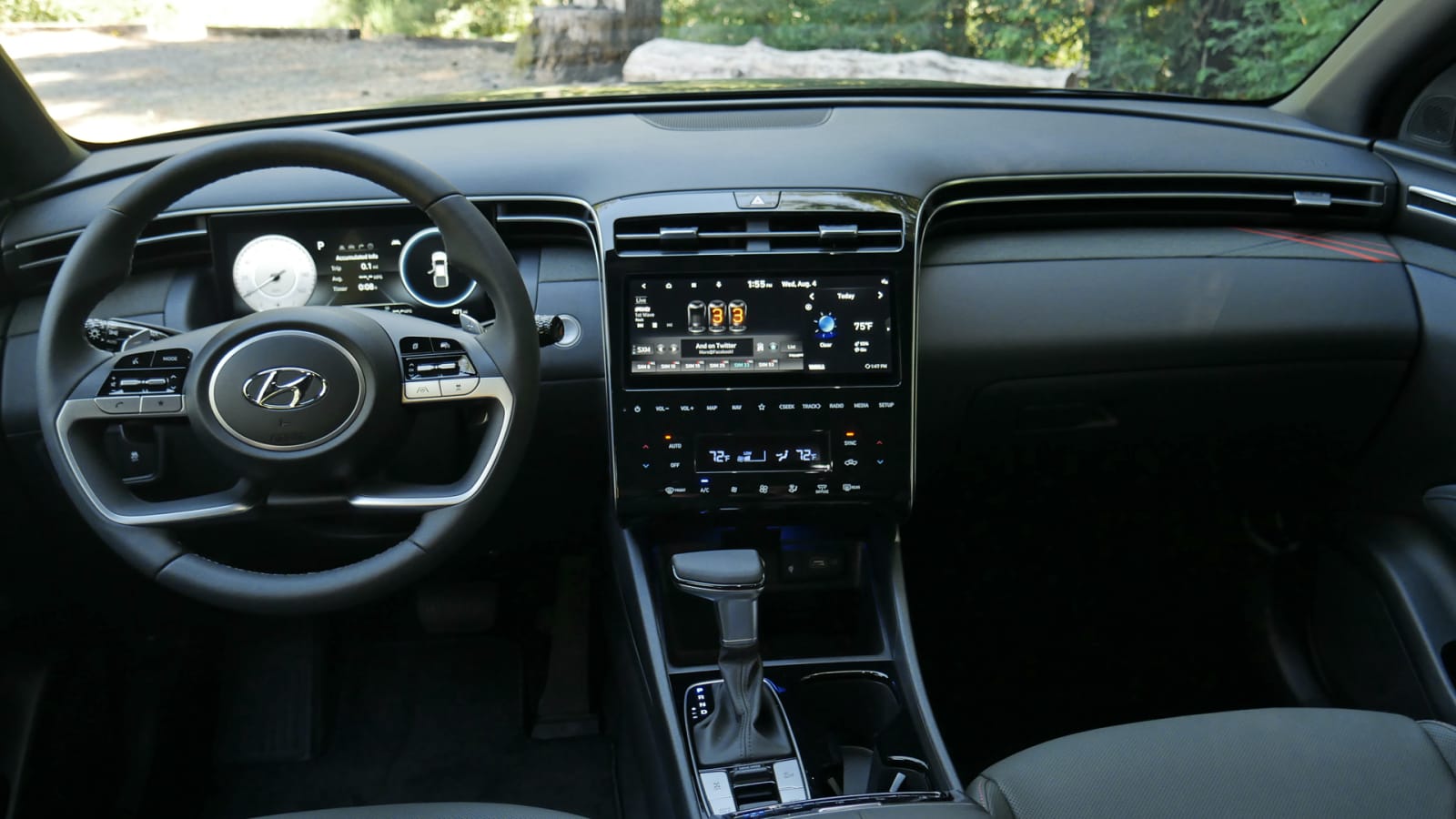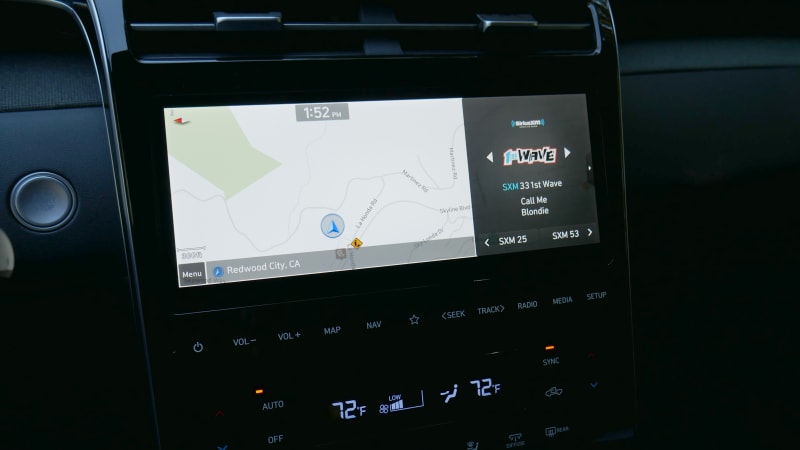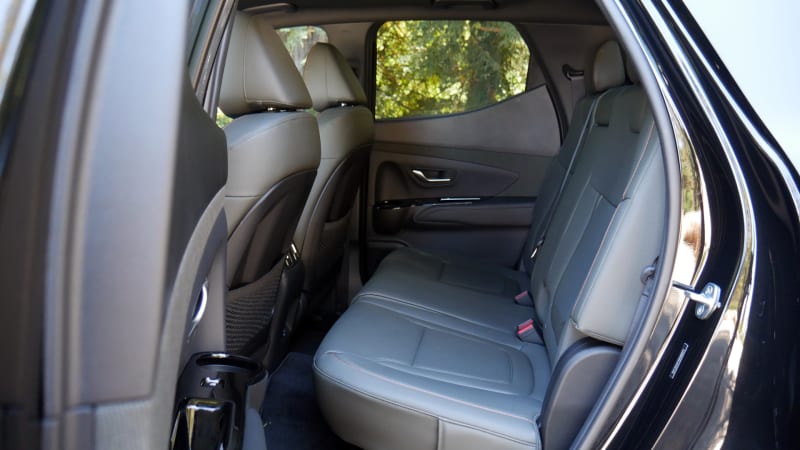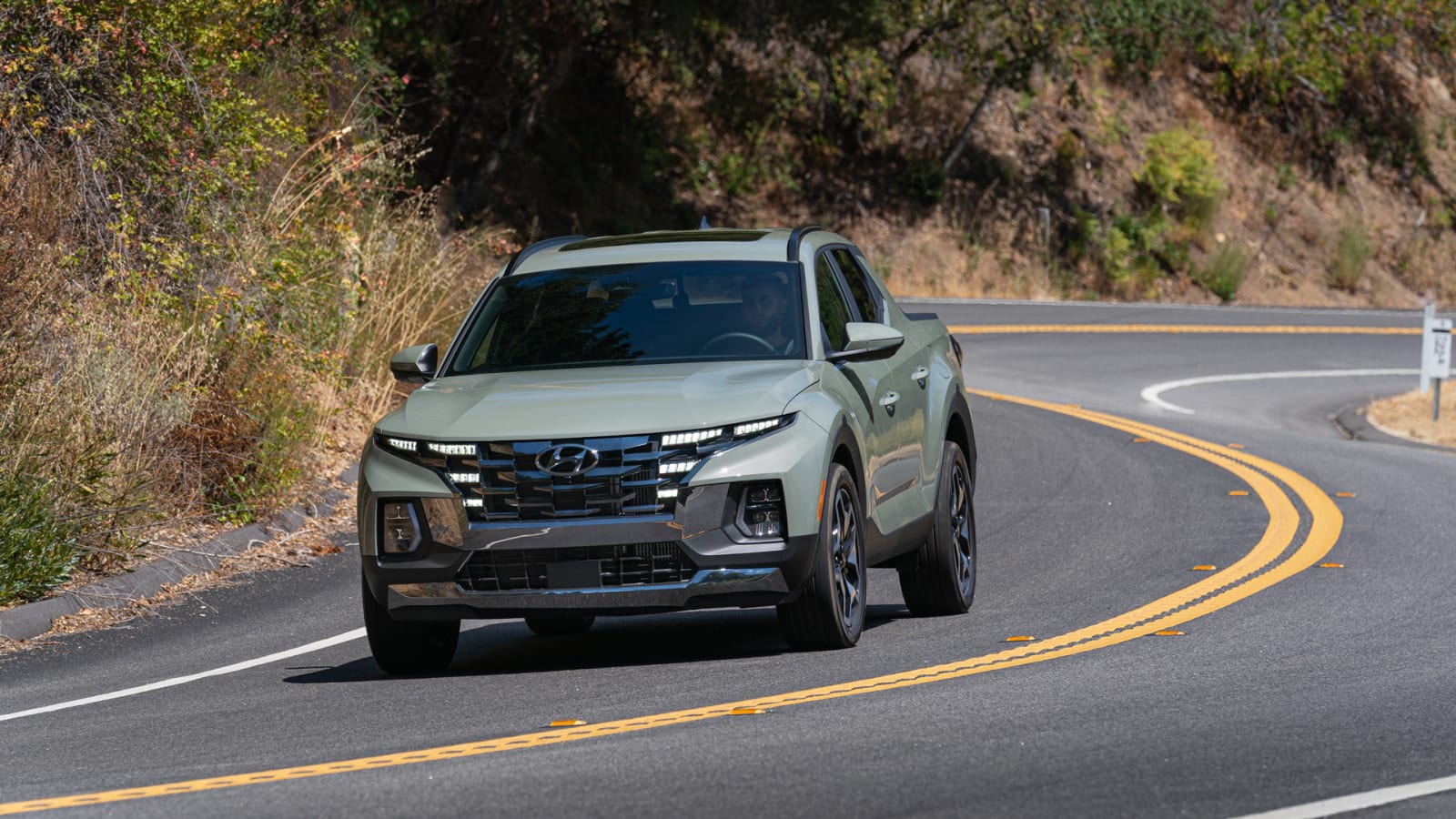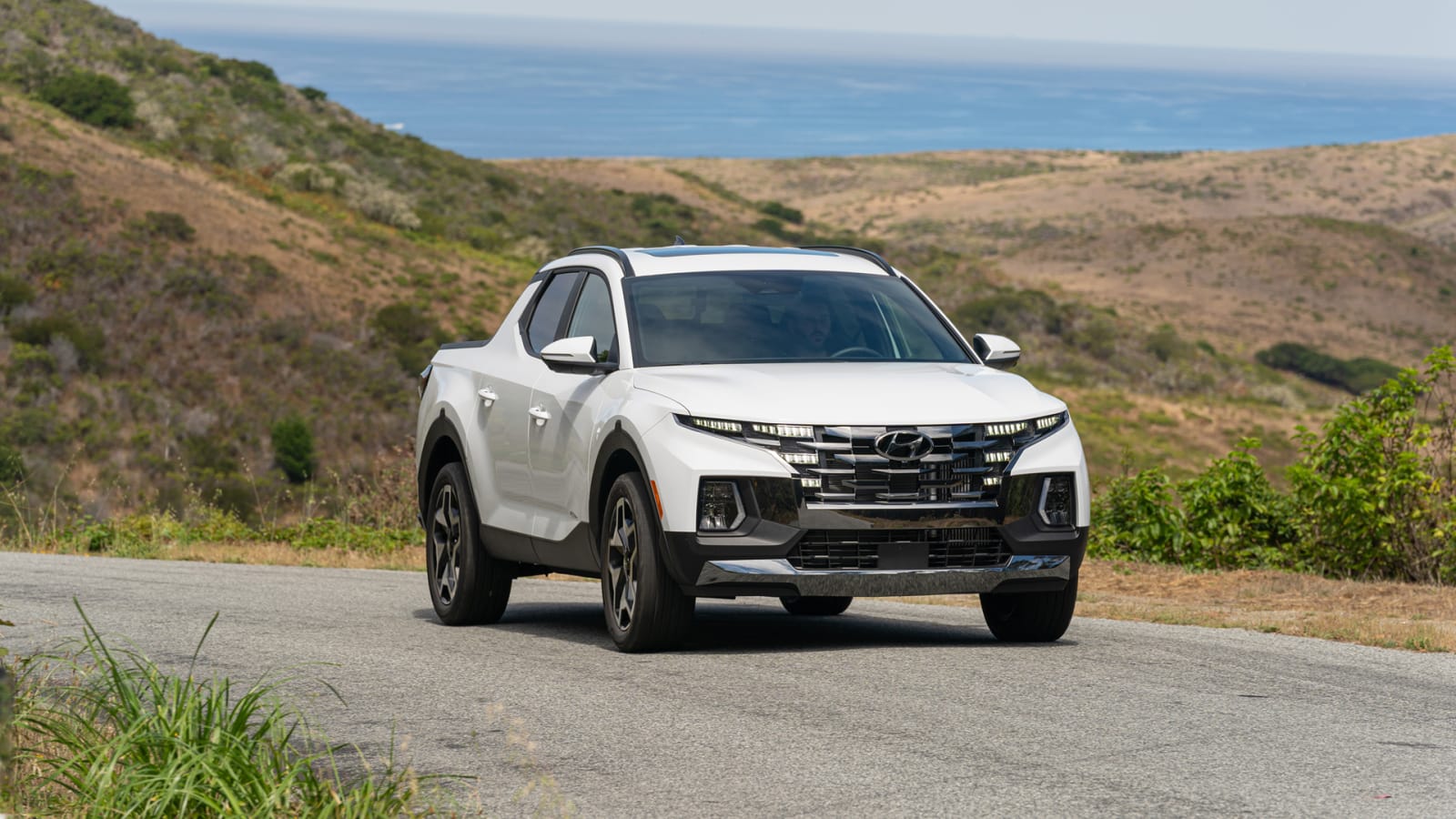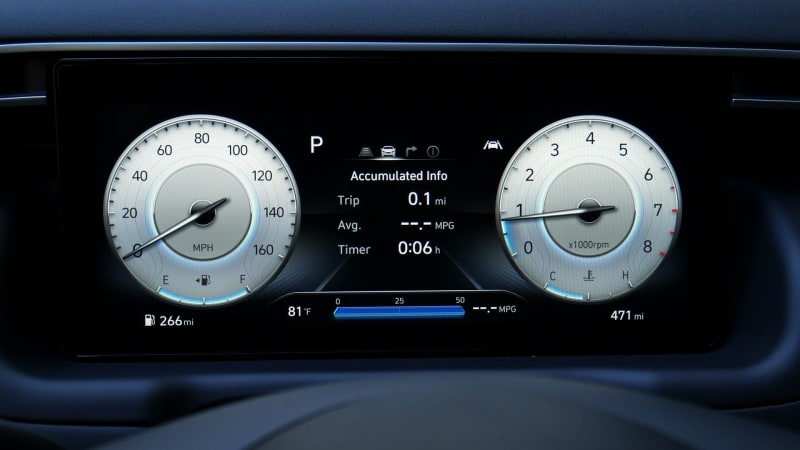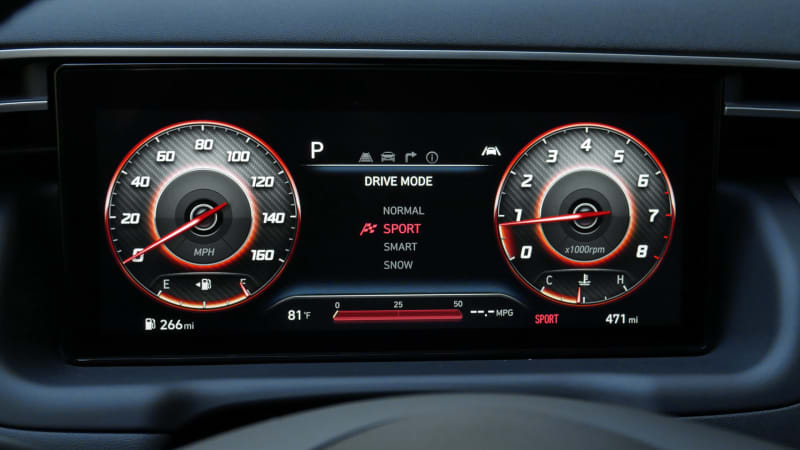The 2022 Hyundai Santa Cruz is an entirely different type of vehicle. Not only is it a compact pickup, measuring far smaller than the Toyota Tacomas of the world, it’s of a totally different construction. Rather than a truck’s usual body-on-frame setup, it has a car-like unibody. In other words, it’s a crossover pickup. That means it’s lighter, more agile and more efficient in terms of both fuel consumption and interior space. It also makes it less robust for off-roading and towing (even if its ground clearance and 5,000-pound max are better than the average crossover), while its diminutive size can best be seen in its small 4.3-foot bed length.
Really, it’s best to view the Santa Cruz as an alternative to compact crossover SUVs rather than midsize pickups. Its open bed, despite being small for a pickup, is still far longer than an SUV’s cargo area and obviously offers infinite height. That could make it more useful for certain buyers. At the same time, its clever available cargo cover that rolls back like a garage door maintains the sort of security and all-weather protection provided by an SUV. This body style definitely has potential.
The Santa Cruz is already for sale, but demand has been very strong, so you may struggle to find one on a dealer lot (or at least one without a hefty dealer markup). Part of that comes down to global supply shortages, but the Santa Cruz is at least good enough to warrant the interest. Of course, it hasn’t faced any apples-to-apples competition yet. Its segment will expand to two when the Ford Maverick arrives – it has a lower-quality interior and we doubt it will be as sporty and fun to drive as the Hyundai, but it also comes standard as a hybrid and is considerably cheaper.
Interior & Technology | Passenger & Cargo Space | Performance & Fuel Economy
What it’s like to drive | Pricing & Features | Crash Ratings & Safety Features
What’s new for 2022?
The Santa Cruz is an all-new model.
What are the Santa Cruz interior and in-car technology like?
The Santa Cruz interior has a more premium look and feel than average for a compact crossover, owing to the fact everything forward of the B-pillar is shared with the impressive new Hyundai Tucson. This gives the Santa Cruz a leg up on the Ford Maverick and justifies, at least to some extent, its higher price. In the Limited trim, the leather upholstery, extra-mile luxury features like ventilated seats and heated steering wheel, widescreen infotainment system and fancy-looking capacitive touch controls step things up even further.
As for the tech, Hyundai’s infotainment systems, whether the standard 8-inch unit or the 10.25 widescreen one shown below, are some of the easiest to use on the market while being feature-packed and modern in appearance. We’re less enamored with those capacitive controls. Though reasonably responsive, it takes too much concentration to find them with your finger amidst the glossy black expanse. Such controls have always had this problem, have always received backlash from owners and have always been replaced with conventional knobs and buttons with the next generation or sooner. We can’t see the Santa Cruz being any different.
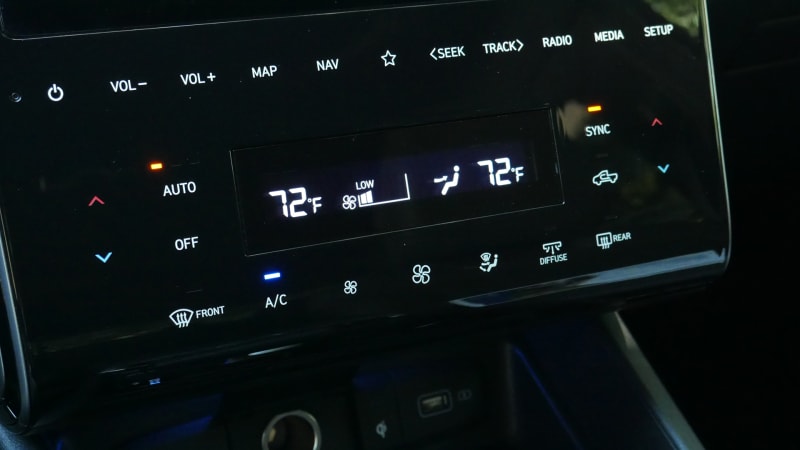
How big is the Santa Cruz?
The answer to this really depends on what you’re comparing it to and which dimensions you’re looking at. For a pickup, the Santa Cruz is very small at 195.7 inches in length. Even the smallest midsize truck, the Nissan Frontier, is 210.2 inches long in its smallest version and goes up to 224.1. Even the other unibody pickup, the Honda Ridgeline, is 210 inches in length. Total height differences are similarly out of whack, though the Santa Cruz’s width is actually similar to midsize trucks and its ground clearance of 8.6 inches is generous. At the same time, the Santa Cruz is hardly small. That length is more than a foot longer than the mechanically similar Hyundai Tucson, which is a pretty average compact crossover in size.
That size difference with crossovers is the result of the Santa Cruz’s truck bed, which is substantially longer than the cargo areas of most SUVs regardless of segment. On the flip side, though, it’s the shortest pickup bed currently on the market measuring 4.3 feet. What it may lack in overall capacity, however, it counters with plenty of clever features that aim to add versatility and security beyond the usual pickup experience. You can read our comprehensive Hyundai Santa Cruz pickup bed review here or watch our video about it below.
When we look inside, we flip things around again. The cabin can actually be more voluminous than the crew cabs of midsize pickups (especially the Toyota Tacoma), with a back seat that’s at the very least more spacious and comfortable. Often it’s better on both fronts. Then again, the back seat has considerably less legroom than compact crossovers and its backrest angle is a bit more upright. The space differences with the Tucson don’t seem as vast as the spec sheet indicates (36.5 to 56.0 inches), but it’s nevertheless significant.
.embed-container { position: relative; padding-bottom: 56.25%; height: 0; overflow: hidden; max-width: 100%; } .embed-container iframe, .embed-container object, .embed-container embed { position: absolute; top: 0; left: 0; width: 100%; height: 100%; }
What are the Santa Cruz fuel economy and performance specs?
The Santa Cruz SE and SEL come standard with a 2.5-liter four-cylinder that produces 191 horsepower and 181 pound-feet of torque, which is a typical amount for the base engine of a compact crossover. It is paired with an eight-speed automatic transmission and standard front-wheel drive, but all-wheel drive is available as an option. EPA-estimated fuel economy is 21 mpg city, 26 mpg highway and 23 mpg combined with FWD and 19/27/22 with AWD. Maximum towing capacity with this engine is 3,500 pounds with trailer brakes and 1,650 without.
The SEL Premium and Limited come standard with a 2.5-liter turbocharged four-cylinder good for 281 hp and 311 lb-ft. That’s more robust, especially in terms of torque, than what you’ll find in midsize pickups. It blows away most compact crossovers. All-wheel drive is standard and the transmission is an eight-speed dual-clutch automated manual. Fuel economy is nearly the same as the naturally aspirated version at 19 mpg city, 27 mpg highway and 22 mpg combined. Its maximum tow rating is 5,000 pounds with trailer brakes (the same 1,650 without), which is 1,000 pounds more than the Ford Maverick and much stronger than the typical compact crossover SUV.
What’s the Santa Cruz like to drive?
The Santa Cruz is one of the most responsive and agile compact crossovers … regardless of what’s going on behind the C pillar. There is absolutely nothing truck-like about it, which is perhaps a bad thing if you desire a bouncy ride, tippy handling and slow steering. Otherwise, it proves to be shockingly sharp and capable of flicking about a twisting mountain road. Nudge the drive mode toggle into Sport and the steering loses its initial bit of off-center numbness in favor of just the right amount of extra effort. The suspension, with its independent multi-link setup at the rear, remains resolutely planted and composed. At the same time, the ride is on the firm end of the spectrum, but not in a truckish way. More in a Mazda CX-5 firm-but-well-damped way.
Then there’s the powertrain. We have not tested the 191-horsepower naturally aspirated 2.5-liter base engine, but our time with something similar in the Tucson would indicate it’ll be unrefined and uninspired, even if it makes competitive power and torque. We have tested the 2.5-liter turbocharged engine, which feels every bit as quick as its ample 281 hp and 311 lb-ft. We just wish you could get it on all trims, especially given its fuel economy relative the base engine.
What other Santa Cruz reviews can I read?
2022 Hyundai Santa Cruz First Drive Review
More in-depth information can be found in this review about the Santa Cruz’s unique design and the engineering that went into it, as well as our initial driving impressions.
2022 Hyundai Santa Cruz Pickup Bed Review
We go deeper into the Santa Cruz’s many innovative bed features, including its lockable rolling tonneau cover and under-bed storage.
How much is the 2022 Santa Cruz price and what is its on-sale date?
The Santa Cruz is on sale now. Pricing starts at $25,215 for the front-wheel-drive SE, including the $1,225 destination charge. All-wheel drive is a $1,500 option on the SE and SEL. It’s also important to note that dealers are likely to place a markup on the Santa Cruz given demand and industry-wide supply issues. This applies to even customers who reserved one on Hyundai’s website as dealers are independent franchises and state laws usually require purchasing a car from a dealer.
Standard equipment is considerable, including 18-inch alloy wheels, rear privacy glass, a composite bed liner, three bed storage compartments, a compact spare tire, stain and odor-resistant cloth upholstery, a manual height-adjustable driver seat, a six-speaker sound system, two USB ports, and an 8-inch touchscreen with Apple CarPlay and Android Auto.
Key upgrades on the SEL ($28,415) include proximity entry and push-button start, heated front seats and an eight-way power driver seat. The Activity package adds a number of desirable extras that include the various bed upgrades (integrated tonneau cover, a 115-volt outlet, LED lighting, utility rails) plus a sunroof, sliding rear window glass, wireless device charging and a 10.25-inch digital instrument panel.
The SEL Premium ($36,905) includes the Activity package along with the turbo engine and standard all-wheel drive, hence its considerable price jump from the SEL. The Limited ($40,945) steps things up firmly into luxury territory with leather seating surfaces, ventilated front seats, Bose audio, capacity interior controls and the 10.25-inch widescreen infotainment system you see here in pictures.
What are the Santa Cruz safety ratings and driver assistance features?
The Santa Cruz has not yet been crash tested by a third party, but it’s also unlikely to vary from Hyundai’s usual exemplary crash rating norm.
Every trim level comes standard with forward collision warning with automatic braking and pedestrian detection, lane-keeping assist and driver inattention warning. Blind-spot and rear cross-traffic warning show up starting with the SEL. Hyundai’s “Highway Driving Assist” adaptive cruise control with stop-and-go capability and lane-centering steering assist is standard on the Limited.
Related Video:
.embed-container { position: relative; padding-bottom: 56.25%; height: 0; overflow: hidden; max-width: 100%; } .embed-container iframe, .embed-container object, .embed-container embed { position: absolute; top: 0; left: 0; width: 100%; height: 100%; }

